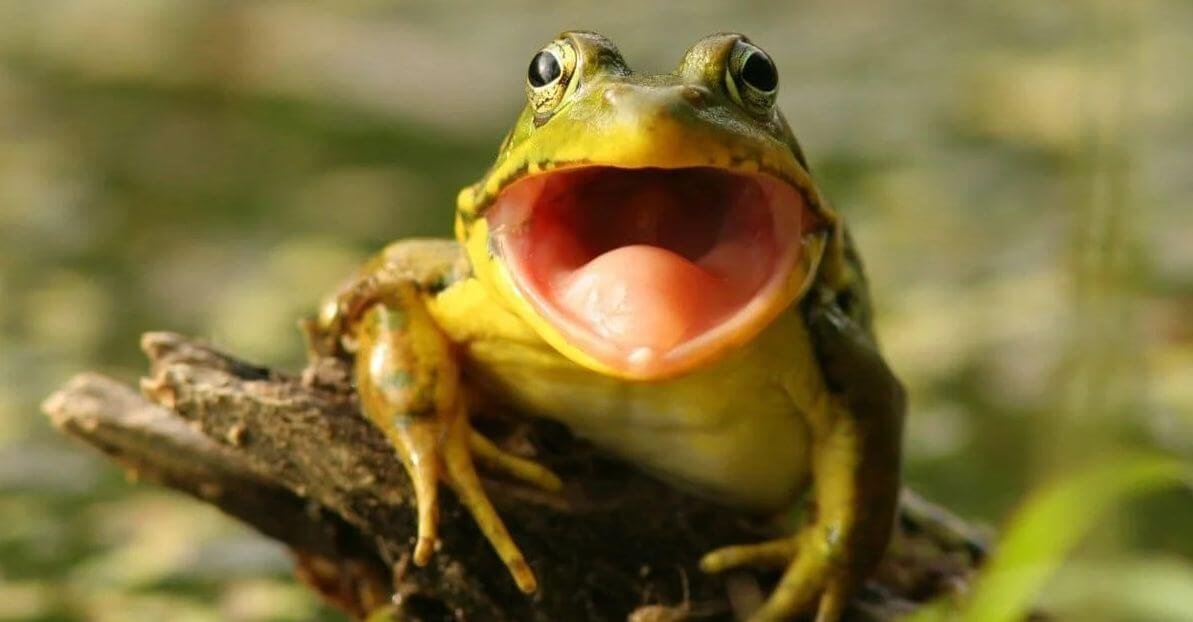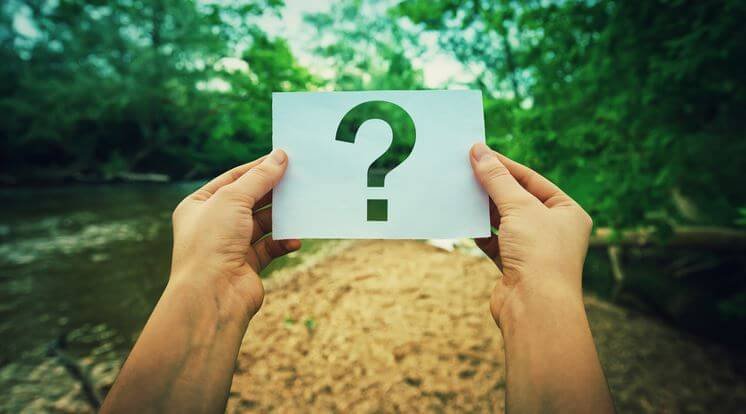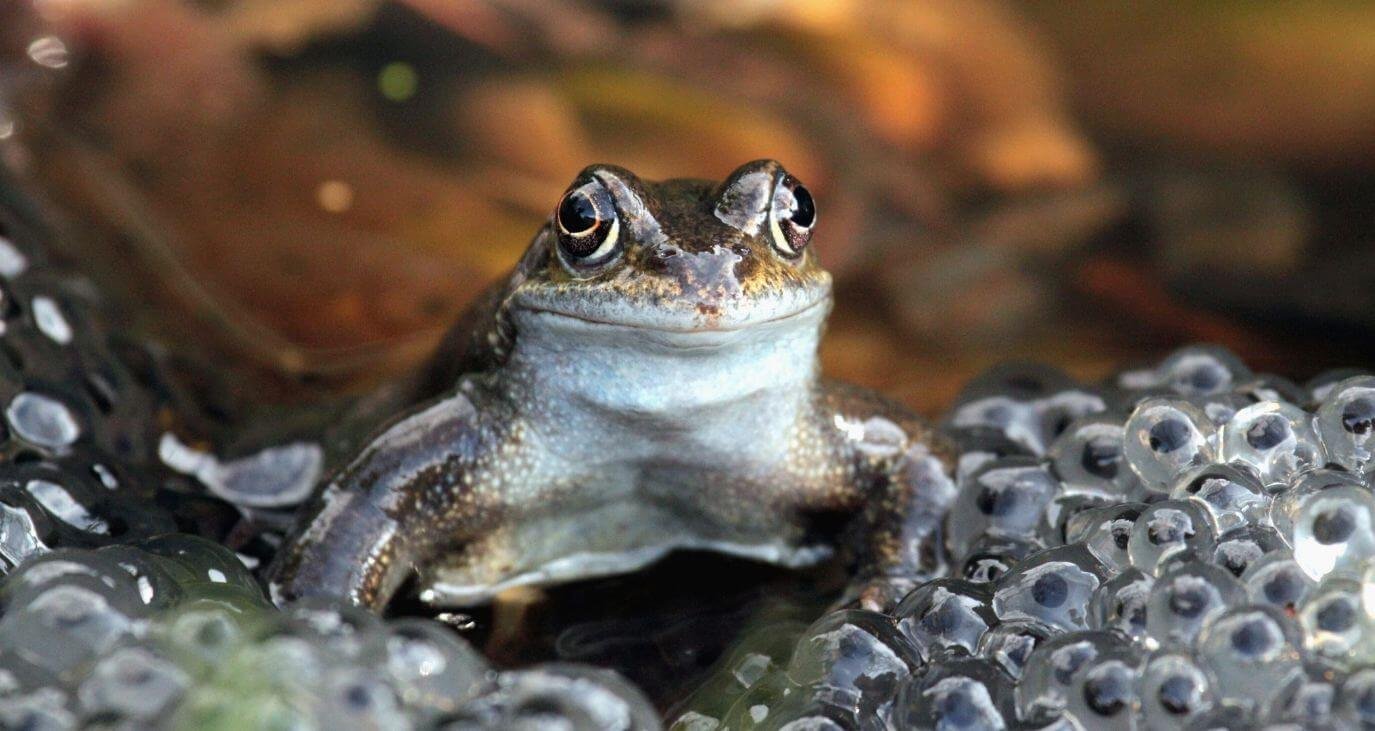It is important to take care of the diet of every pet you have. Do you have a pet frog? Have you kept it in a pond made in your house? Do you know what to feed it or have you left it in the pond to eat whatever it finds on its own? If it is so, you are going the wrong way and are risking the life of your pet frog.
The diet of each frog is different depending upon his age. In this guide, we will explain what pond frogs eat and how to feed them. They are also living organisms who need a proper diet to live long or at least survive.
Most pond frogs eat insects like crickets, beetles, caterpillars, worms, snails, etc. There are many types of insects that are included in the frog’s food. Some larger frogs also eat small fish so take care of your fish if they are in the pond.
Let’s have a look at the feeding needs of a pond frog:
Contents
What Do Pond Frogs Eat?
Pond frogs not only eat insects and small fish, but they also eat each other? Isn’t it strange? You must be thinking about how a frog can eat another frog? Let us tell you the larger frogs are more likely to eat newly born frogs. So, we recommend you keep the newly born frogs away from the larger ones to save their lives.
Following are some of the food examples included in the diet of a pond frog:
Small Fish
Small fish are so small in size that they can easily be attacked by larger organisms like an elder frog. These newly born fish are not only attacked and eaten by frogs but also larger fishes. If you want to save their life, it would be best to keep these fish away from larger organisms where there is a risk to their life.
Pond frogs also eat decaying fish, their eggs, and larvae. We can say that the large frogs are fond of preying on smaller fish living in the water. Let us tell you a fact that some fish also eat frogs. These big fish include muskellunge, spotted bass, largemouth bass, smallmouth bass, walleye, catfish, pike, redfish, and snook.
Insects
Eating insects is the most common diet of pond frogs. No matter what insect it is, small or larger, the frog will surely attempt to eat it! We can say that the frogs are always craving the insects and are always attracted to them to catch them no matter how full their tummy is.
Large frogs eat large insects like cockroaches, grasshoppers, termites, spiders, etc. These are the insects that are quite larger than small insects like bees. Large frogs also eat beetles, grubs, butterflies, and wasps. They also like to eat crunchy and small grubs like mealworms and juicy grubs like beetle larva.
Yolk
When a frog is newly born, it does not know how to eat. It is not aware of how to eat the insects and what diet it should take. So, until six weeks, the frogs are fed on the remaining yolk of their egg. After six weeks, they become able to eat phytoplankton and algae.
When the frogs grow their feet, become able to move here and there on their own, and become developed after six months, they become omnivores. They start eating ants, aphids, and zooplankton. Later on, you will see them eating insects too!
Small Insects
Small frogs are more likely to eat worms, slugs, snails, moths, flies, etc. When they see any insect, they use their sticky saliva and long tongues for catching the prey. You will be amazed to see the insect-catching speed of the frog. It is too fast that the insect doesn’t get time to fly away.
Small frogs eat the insects and worms that are small in size such as bugs, crickets, woodlice, ants, flies, termites, aphids, and fleas. The food choice of small frogs is limited as compared to the larger ones but they eat more small bugs.
For your information, crickets, grasshoppers, and termites are insects that are very rich in protein and are considered one of the best and excellent food sources for all types of pond frogs, but not the newly born frogs.
Leafy Greens
Green leaves present in the pond are also included in the diet of pond frogs. They also eat the leafy greens that are present in your garden. This food type also includes detritus, phytoplankton, duckweed, zucchini, kale, spinach, watercress, cabbage, leeks, lettuce, and cucumber skins, boiled broccoli, and algae.
How Do Pond Frogs Eat?
Before attacking the prey, the frogs spot it first. It waits for the right moment to attack the prey so it could not run or fly away. For example, the frog prey has spotted a bug to eat, it licks the bug up with its long sticky tongue and then swallows it down through its throat.
Pond frogs also use their eyes for pushing the prey down into their stomach. It is the place where the prey dies completely. Then, it is fully digested in the frog’s stomach and excreted later on.
Pond Frog Feeding Methods

We know that the animals use their tongues to grab their food and eat. But it can only be done by adult animals. In the case of newly born animals, whether their mother feeds them or if they are pets, you have to feed them yourself. When they are not fed properly, they may die.
So, if you have a pet pond frog, you must know how to feed it. If you are concerned about its diet and do not want to leave it on its own, take care of its diet. Following are some of the feeding methods that can be used for feeding the pond frogs depending upon their age:
Using a Spoon
Newly born frogs are small enough that they cannot eat themselves, so you need a tool that can be used to feed them. You need a spoon to prepare the food for these frogs so you can easily drop the food in them.
The most common food items that are prepared using the spoon and are served with it to the pond frogs include green peppers, zucchini, spinach, cabbage, leeks, lettuce, cucumber skin, kale, and broccoli.
Using a Pipette
You can also use a pipette for feeding your pet frog. A pipette is like a slender tube that is usually used for transporting a specifically measured amount of liquid from one place to another. You can fill it with the frog’s food and then feed it using the pipette.
Pipette is mostly used for feeding the newly born frogs with raw egg yolk. You can also use it to feed other frogs if you want but make sure the food is in liquid form.
Using Tweezers
Tweezers are used for feeding the frogs whose age is more than 6 weeks or older. You can use tweezers to feed them with mosquitoes, ants, small fish, and aphids. We can say it cannot be used for feeding newly born frogs because they cannot eat such food.
Side Effects of Overfeeding Pond Frogs
Overeating is bad for all organisms no matter if it is human beings, animals, plants, etc. When you overfeed the frogs, the following are the side effects you have to face. Let’s have a look at them:
- When you feed the frogs too much or all day, it leads to obesity. It makes the frogs ill or may also result in killing them.
- The frogs may start vomiting if they eat something which is very large in size. For example, when a six-week frog tries to eat a cockroach or a grasshopper, it may vomit.
- Constipation is common when a frog is overfed. It would be best to keep the frogs away from food when you think they have had enough.
- When the pond frogs ingest a food item that is very large in size, they start choking. This choking might also lead to death. So, keep them away from such things.
- When a pond frog tries to eat something large in size, this food item may rot in the stomach of the frog which results in building up gas in the stomach and start producing bacteria there.
How Often A Pond Frog Should Be Fed?
It would be best if you feed your pond frogs once a day. Make sure they are fed at the same time every day. It is recommended to you to keep the feeding process steady and stop feeding it when it stops eating otherwise not. Never ever overfeed your pond frogs otherwise their health is affected very badly.
When you add too much food to the aquatic space, it can become rotten. So, it would be best to not provide the extra food that is wasted. Not only the food is wasted, but the water also becomes tainted and murky. So, whenever you notice there are leftovers in the water, remove them right over.
No doubt, it is a challenging task to feed a pond full of hungry frogs. It surely requires a lot of effort and time. So, fix a specific time in the day when you decide to feed your pond frogs
How To Prepare Herbivore Diet For Pond Frogs?

If you want to feed your pond frogs with leafy green food i.e. herbivore diet, you need to go through a complete organic procedure to feed them healthy food. Following are some of the steps you need to follow for this purpose:
- First, you have to get fresh vegetables and greens. You can also get them from grocery stores but make sure they are free of pesticides and chemicals. It is because the frogs are sensitive and harmful chemicals may have a bad or negative impact on their health. So, make sure you wash the vegetables and greens thoroughly before moving to the next step.
- Secondly, you have to cut the food into little pieces. We know that the frogs have very small teeth so they cannot eat vegetables directly. They also have a very sensitive digestive system that’s why they cannot chew the food completely. So, make it easier for them to eat which can be done by cutting the vegetables and greens into small pieces. It will be easy for you to feed them using a spoon and will also be helpful for them to digest it easily.
- The next step is to boil these greens and vegetables. Make sure they are cooked properly before you feed them. The purpose of boiling is to kill all the microorganisms present in the food. In this way, bacteria-related risks are lowered. When you are done boiling it, let it cool down before you feed it to your pond frogs.
- When you are done feeding the frogs and there is enough food left behind, it would be best to freeze it so it can be preserved for feeding the next time. Freezing is the best option to plan the daily meal for these frogs. Freezing the greens and vegetables also requires being cut down so make sure they are cut down into smaller pieces. You can freeze it right after washing and skip the boiling part.
Frequently Asked Questions (FAQs)

Do frogs have teeth?
Baby frogs do not have teeth but after six months, their upper jaw helps them swallow their food and keep it down. Their teeth are only visible from the inside of their mouths.
How can I feed a newly born frog?
You can use a spoon or pipette for feeding the newly born frogs with the eggs’ yolk.
How do the pond frogs breathe?
The pond frogs breathe through their skin which is very thin and allows the oxygen to pass through when the frogs are in the pond.
What bugs do pond frogs eat?
Pond frogs eat cockroaches, fleas, termites, crickets, katydids, grasshoppers, lice, woodlice, and many other bugs you may not even have ever heard of.
What happens if you overfeed the frogs?
If you overfeed the frogs, it may lead to constipation, choking, difficulty in breathing, or even death.
Conclusion
You should feed your pond frogs like you feed a pet. You should take care of their diet from the early stages. It is because when they are very small or newly born, they cannot move from their place and cannot eat insects so you have to feed them with egg yolk. We have explained everything about the diet of pond frogs so seek help from it and take care of them. Never think of overfeeding them because you are risking their lives in this way.


![08 Best Filters For Goldfish Tanks [Compared & Reviewed]](https://youraquariumguide.com/wp-content/uploads/2021/11/Best-Filters-For-Goldfish-Tanks-300x155.jpg)
![10 Best Pond Muck Removers [Comparison & Reviews]](https://youraquariumguide.com/wp-content/uploads/2022/03/Best-Pond-Muck-Removers-300x170.jpg)
